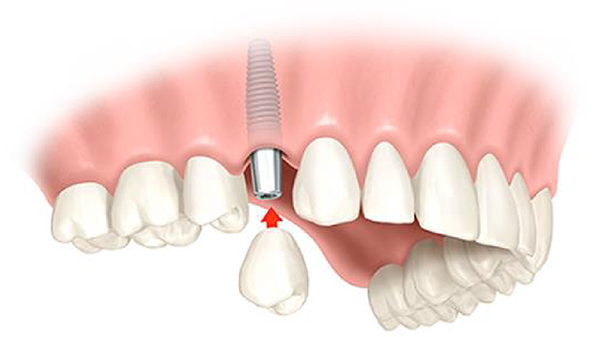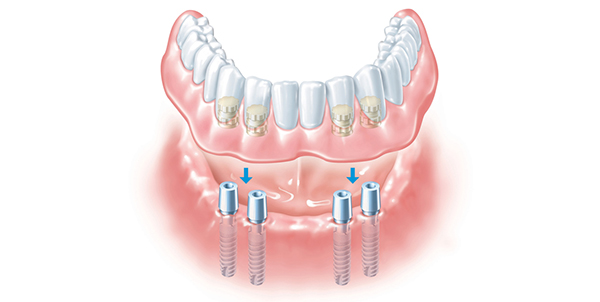
Implantology
Dental implants replace the missing roots and are the firm support for crowns, bridges or prosthetics. Dental implants are the right choice when:
- One tooth is missing
- Multiple teeth are missing on one side
- Partial or total toothlessness of upper and/or lower jaw
In order to place a dental implant properly it is necessary to check that the width and depth of the bone tissue in the area of the missing tooth/teeth is sufficient. The availability of the bone structure is checked on Cone Beam Computed Tomography (CBCT) image, which is nowadays available to every dentist. Based on the analysis of that scan, in accordance with the principles of dental reconstruction and respecting the patint’s wishes, a maxillofacial surgent in a team with a prosthodontist plan the optimal number and alignemt of implants for each patient individually. If the jawbone is too eroded to support dental implants, it is necessary to build up the bone by using other surgical techniques.

What are dental implants made of?
Dental implants are most often made of 99.9999% titanium. It was in Sweden in 1965 that the first titanium implants were placed into human jawbone. Titanium is a biocompatible material which in contact with the bone tissue forms firm foundation and that process is called osseointegration. The process of implant osseointegration lasts from 3 to 6 months after which it can support replacement tooth. The factors that affect the speed of osseointegration are bone quality (density) and achieved stability of the implant shortly after it is placed. How fast the implant will be able to support the replacement also depends on the number and alignment of the implants. Nowadays there are implants with an active surface for osseointegration, shortening the healing process to only 3 months (SLActive® – Straumann).
Dental implant surgical procedure
After analyzing the CBCT image and in compliance with the pateint’s wishes and needs, we carefully make a paln where to place the implants. We keep the patient fully informed about the plan and dynamic of the treatment. If the patient agrees with the suggested procedure, and if there are no contraindications to dental implants, the patient signs the consent asllowing the surgen to proceed with the surgical treatment. The surgery itself is most often done in local anesthesia (or with sedation), and is less traumatic for tissues than many other oral surgical procedures. Although painless and seemingly simple surgery, it requires a great deal of experience so that the implants are placed ideally in relation to each other, neighbouring teeth and the opposite jaw teeth. Inadequatly placed implants can cause problems with teeth replacement they have to support. Also, incorrectly placed implant can be subjected to traumatic forces through prosthetic crown which can shorten its lifespan. It takes about 15 minutes to place one dental implant. Once the placement is done the patient is given the original manufacturer’s certificate on dental implants which guarantees the origin and the quality of the placed implants.
Healing after dental implant placement
Once the surgery is done the patient is instructed how to behave, maintain hygiene and how and what to eat. We always prescribe antibiotics, medicines aginst pain and swelling. Body reacton to dental implants is usually very mild and with symptoms which can be eliminatewd by medicines. Reactions are, of course, individual, but it is important that the doctor recognizes any kind of complications, which are not that often, on time.
Teeth replacements on dental implants – when and how?
After the process of osseointegration is finished, x-ray image and clinical examination will show if implants can carry the load, which is usually 2 to 3 months after the surgery. If everyting is fine, the healing cap is removed from the implant and the gingiva formers are placed for shaping the gum around the future crown. 7 to 10 days after that we start the procedure of making dental prosthesis according to patient’s wish and in compliance with the principles of contemporary prosthodontics. The implants can carry ceramic-metal/zirconia crowns, ceramic-metal/zirconia bridges, skeletal or total prosthesis.
What dental implants are the best?
Nowadays there is a wide choice of dental implants. The ones with the longest tradition and the most developed research centres are Straumann and Nobel. Decades of develepement, research and extraordinary results follow these two manufacturers, which also justifies their high prices. However, the other less expensive dental implants also have great results and they give a lifelong guarantee for their products. Amoung them are Alpha Bio, Neodent, Bredent, BioHorizon and others.
![]()

![]()
![]()








